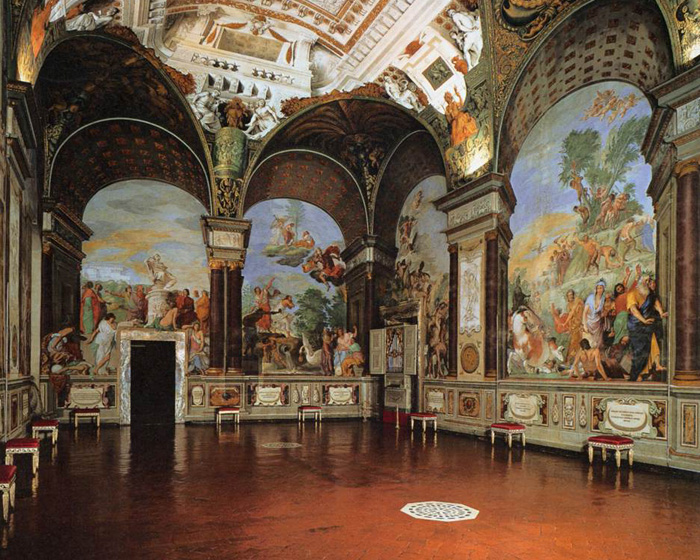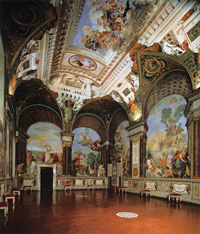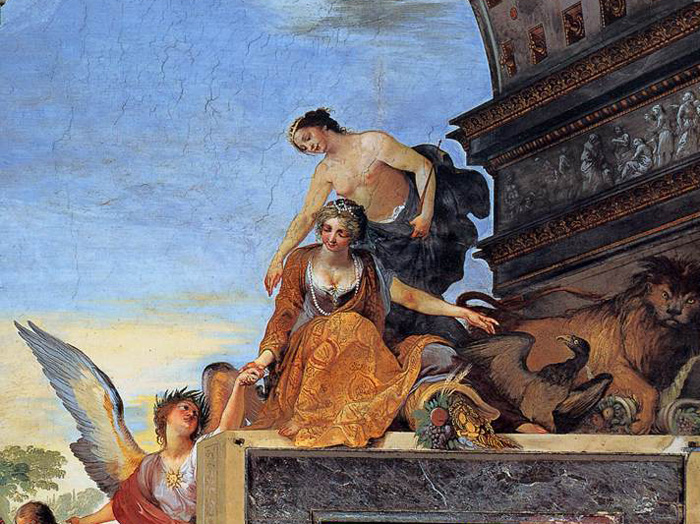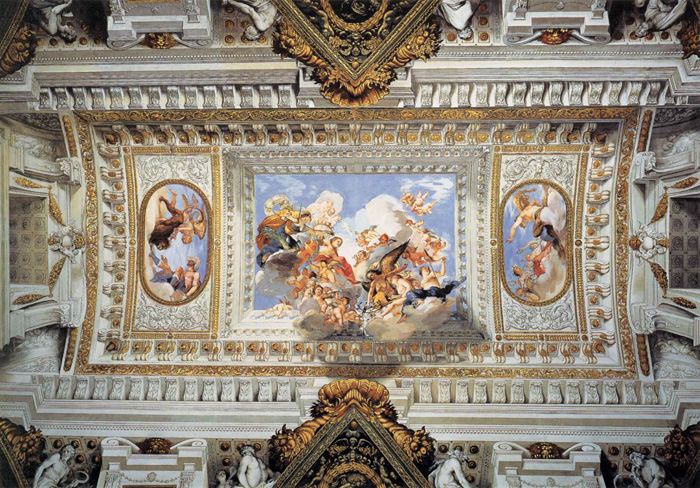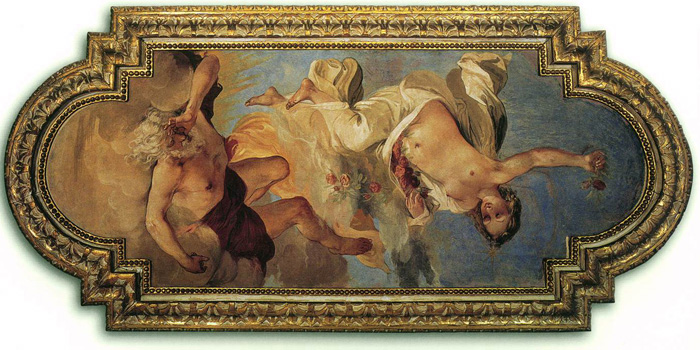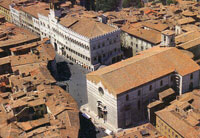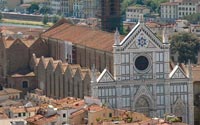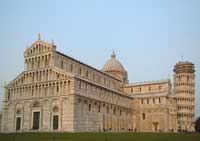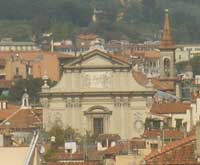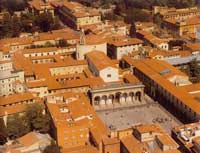| |
|
Fin da giovane dimostrò una predisposizione per la pittura, contrastata dalla famiglia che lo voleva notaio e chierico. Nel 1608 si trasferì a Firenze e divenne, fino al 1612, allievo di Matteo Rosselli e più tardi di Giulio Parigi, architetto, scenografo e incisore.
Il pittore, dalla personalità piena di curiosità e di arguzia, trascorse un periodo a Firenze conducendo una vita che viene descritta dal biografo Francesco Saverio Baldinucci come "stravagante": ad un'ossessiva applicazione allo studio del disegno e a letture di poesia e storia si accompagna un apparire trasandato.
La sua iscrizione alla Accademia delle Arti del Disegno di Firenze risale al 1612 e nel 1616 si hanno le prime opere. Predilesse subito la tecnica dell'affresco.
Morì a Firenze, il 9 dicembre 1636; è sepolto nella chiesa di San Pier Gattolino.
La Casa Natale del Pittore si trova a San Giovanni Valdarno in Corso Italia al n.105, e fa parte dell'iniziativa Musei, Case della memoria per la conservazione e diffusione della storia dell'arte toscana.
Opere selezionate
La circoncisione, chiesa di San Bonaventura delle monache clarisse di Cutigliano.
1616-1619, Chiesa di Ognissanti a Firenze, decorazione della cupola e pittura ad affresco di cinque delle lunette del chiostro.
1620, Decollazione del Battista, presso il museo della Basilica, comune di San Giovanni val d'Arno.
1620-1622 La prima notte di nozze, Firenze, Galleria Palatina, Sala delle Allegorie
1623-1624 Cristo servito dagli angeli, Firenze, Galleria Palatina, Sala delle Allegorie
1627 Venere pettina Amore, Firenze, Galleria Palatina, Sala delle Allegorie
1634 Matrimonio mistico di Santa Caterina d'Alessandria, Firenze, Galleria Palatina, Sala delle Allegorie
1634 La Pittura che dipinge la Fama, Firenze, Galleria Palatina, Sala delle Allegorie
La sua ultima opera, rimasta incompiuta, fu la decorazione con affreschi di un salone che porta il suo nome, al pianterreno di Palazzo Pitti.
|
|
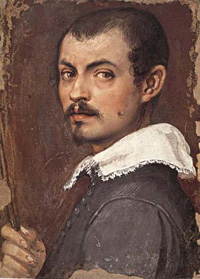 Giovanni da San Giovanni, Selfportrait, Galleria degli Uffizi, Coridor Vasari, Florence Giovanni da San Giovanni, Selfportrait, Galleria degli Uffizi, Coridor Vasari, Florence
|
|
|
Room of Giovanni da San Giovanni, 1635, fresco, Galleria Palatina (Palazzo Pitti), Florence
|
La Galleria Palatina è un museo ospitato in Palazzo Pitti a Firenze. Si tratta della "quadreria" dei Granduchi di Toscana: l'allestimento infatti rispetta il gusto dei secoli passati, con i dipinti collocati su più file selezionati per criteri decorativi, e non per periodo e scuole. Cronologicamente, a parte qualche eccezione, i dipinti coprono soprattutto i secoli XVI e XVII, facendone uno dei musei più importanti in Italia nel suo genere.
|
|
|
Fame Showing the Wandering Philosophers to Tuscany and Munificence
|
|
Fame Showing the Wandering Philosophers to Tuscany and Munificence, c. 1635, fresco, Galleria Palatina (Palazzo Pitti), Florence
|
The picture shows part of the fresco decoration in the Room of Giovanni da San Giovanni.The arrivals of poets and philosophers in Tuscany after their "expulsion" from Mount Parnassus is an allusion to the fall of Constantinople into the hands of the Turks in 1453, after which Lorenzo the Magnificent offered refuge in Florence to Greek scholars who fled the Eastern capital. Recognizable are the figures of the seated Empedocles, wailing over the loss of books, as well Aristotle and Plato. The seminude allegory of Tuscany standing behind Munificence receives the wanderers who are being recommended to her by winged Fame.
|
|

Fame Showing the Wandering Philosophers to Tuscany and Munificence, c. 1635, fresco, Galleria Palatina (Palazzo Pitti), Florence
|
|
|
Allegory of the Marriage of Vittoria della Rovere with Ferdinando II de' Medici, 1637, fresco, Galleria Palatina (Palazzo Pitti), Florence
|
The picture shows the ceiling fresco in the Room of Giovanni da San Giovanni. In 1637, Ferdinando II de' Medici, Grand Duke of Tuscany, married Vittoria della Rovere, last heir of the Dukes of Urbino, whose extraordinary dowry of art objects enormously enriched the already conspicuous outstanding Medici collections.
|
|
|
|
|
Giovanni da San Giovanni, Aurora and Tithonus, 1634-35, detached fresco, 360 x 160 cm, Museo Bardini, Florence
|
Aurora was the sister of Helios, the sun-god. Every morning she rose from her bed leaving her aged husband Tithonus still sleeping, and led Helios into the heavens. She was a popular figure in seventeenth-century Baroque ceiling painting. Giovanni da San Giovanni's painting was originally at centre ceiling of a room in Pucci Palace in Florence, as can be seen from the much foreshortened figure of Tithonus.
|
|
|
| |
|
 |
|
|
[1] Matteo Rosselli was an influential artist of the early 17th century in Florence, he is described by the early sources as being of a gentle disposition and as a dedicated and dignified painter, although he lacked originality and power. His work is characterized by the simplicity, descriptive naturalism and refined colour of the Counter-Reformation art created by such Tuscan artists as Santi di Tito, Bernardino Poccetti, Lodovico Cigoli and Domenico Passignano, yet he was also responsive to Venetian and Emilian art.
The son of Alfonso Rosselli and Elena Coppi, he received his early education in Gregorio Pagani's studio, which he attended from as early as 1587. His initial inclination was towards classical and balanced compositions, in which the influence of Andrea del Sarto, whose frescoes he copied in the Chiostro dello Scalzo, is clear. On 26 February 1599 he was admitted to the Accademia del Disegno and in 1605 went to be with Passignano in Rome for six months, greatly enriching his artistic experiences through this contact. He returned to Florence in the same year and, on Pagani's death (1605), completed his master's unfinished works with great success. Pagani's influence can be seen in the bright colours of Rosselli's Adoration of the Magi (1607; Montevarchi, Arezzo, S Andrea). To 1610 belong two monochrome paintings depicting Henry IV at Nantes and Henry IV at Gaudebec (Florence, Pitti, repository), executed for the funerary ceremonies that took place in S Lorenzo on the death of the French sovereign. Rosselli's interest in fluent, fresh and richly anecdotal narrative, indebted to Poccetti, is already evident in these works. In his Crucifixion (1613; Scarperia, Prepositurale), still within a Florentine tradition, there is a more varied chiaroscuro and a more expressive and softer handling, which suggests a response to Coreggio, whose art he probably knew through Pagani.
His interest in anecdote found its full expression in the lunettes (1614-18) depicting scenes from the lives of the founders of the Servite Order in the Chiostro dei Morti of the church of the Annunziata, Florence, and is also demonstrated, in combination with the brilliant colour of his earlier paintings, inspired by Lodovico Cigoli, in his Last Supper (1614; Florence, Conservatorio di S Pier Martire). To 1615 belongs the painting of the Fortifications of San Miniato, the first of three scenes (the others were completed in 1627 and 1628) drawn from the life of Michelangelo whose nephew, Michelangelo Buonarroti the younger, commissioned them for the Casa Buonarroti, Florence. Here the rhetorical gestures are softened by the realism of the facial expressions and by the landscape, which is enriched by lively figures in the background.
From 1619 Rosselli won the patronage of such important families as the Medici, the Corsini and the Dragomanni, and his activity increased. For the reception rooms of the villa at Poggio Imperiale he executed frescoes portraying the emperors Charles V, Frederick II and Maximilian I as well as biblical and historical heroines, datable to between 1619 and 1623. He took part in the frescoed decoration (1620) of the façade of the Palazzo dei dell'Antella in Piazza Santa Croce, Florence, and in 1621 won the commission for the Triumph of David (Florence, Pitti) and for the pair of paintings depicting Lot and his Daughters and Tobias and the Angel (1621; Florence, Galleria Corsini). The Triumph of David is a successful work, with skilled chiaroscuro and a disciplined yet intense atmosphere; the latter two works are characterized by more idealized figures, more classical compositions, and a greater delicacy of handling. These qualities distinguish this period of the artist's work. Further decorations (1622-3) were commissioned by Leopoldo de' Medici for the Casino di S Marco; these works, rich in echoes of Venetian art, depict the Rebuilding of the Port of Livorno by Frederick II and the Capture of Ippona (Florence, Corte d'Assise). Leopoldo also commissioned from Rosselli the allegorical paintings (1622) in the Sala della Stufa in Palazzo Pitti.
|
|
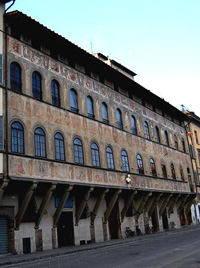
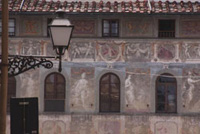
Il Palazzo dell'Antella in Piazza Santa Croce fu affrescato sulla facciata da un team di 13 pittori guidati da Giovanni da San Giovanni (1619)
|

|

|

Se stai cercando una casa di vacanza nella Maremma Toscana per trascorrere una bellissima ed emozionante vacanza scegli Podere Santa Pia. La Casa Vacanze Podere Santa Pia è situata sulla sommità di una collina all’interno della Maremma da cui si gode una splendida vista sull’intera vallata, dai Monti dell’Uccellina fino al mare e Monte Christo.
La zona è costellata di borghi medioevali che in gran parte mantengono la struttura urbanistica originaria, dai meni frequentati, come Roccalbegna, Semproniano, Sovana, Sorano e Montemerano.
Per gli amanti del buon vino, non c'è che l'imbarazzo della scelta: in meno di 20 minuti vi ritroverete immersi nelle colline di, Montalcino e del Val d'Orcia, famoso per il suo Brunello di Montalcino e per le bellissime distese di vigneti.
Case vacanza in Toscana | Podere Santa Pia
|
| |
|
|
|
|
|
|

|
Podere Santa Pia |
|
Podere Santa Pia, terrazza
|
|
Sant'Antimo |
| |
|
|
|
|
|
|
|
|
|
Perugia |
|
Santa Croce, Florence |
|
Pisa, Duomo
|
| |
|
|
|
|
|
|
|
|
|
The façade and the bell tower of
San Marco in Florence |
|
Piazza della Santissima Annunziata
in Florence
|
|
Florence, Duomo |
| |
|
|
|
|
Palazzo Pitti, which houses several important museums, was built in the second half of the 15th century probably on a project of Filippo Brunclleschi for Luca Pitti, but was unfinished at his death in 1472. The original building, formed by two floors and the ground floors, with only live windows on each floor, was purchased in 1550 by Eleonora da Toledo, the wife of the Grand Duke Cosimo I de` Medici, thus becoming the official residence of the family. For this reason it was widened and changed, in 1560 by Bartolomeo Ammannati and at the beginning of the 17th century by Giulio and Alfonso Parigi. The latter two architects gave the facade its present day aspect, with the only exception of the two lateral projecting pavilions that were built in the age of the Lorraine family and completed during the first half of the l9th century by Paoletti and Poccianti, who also built the Palazzina della Meridiana, added on to the rear section of the palace overlooking the garden.
Most of the internal decoration was also executed during the 17th century by Giovanni da San Giovanni, Pietro da Cortona, il Volterrano, Antonio Domenico Gabbiani and Sebastiano Ricci.
As regards the domestic life inside the palace, we know that it was the home of several components of the family who were distributed in different private apartments. The rooms on the left wing belonged to the Grand Duke, while those on the right side were used by the heir. The lateral wings housed the apartments of their wives. The rooms on the second floor contained the large library, while the side rooms were used for the children. The left side on the ground floor housed the apartment that the Grand Duke used in summer.
Today, the palace and the Boboli gardens house the Palatine Gallery, the Silver Museum, the Museum of Modern Art, the Costume Gallery, the Porcelain Museum and the Museum of Carriages.
Galleria Palatina | The Gallery takes its name from the fact that it is located in the palace of the reigning family and was opened to the public by the House of Lorraine in 1828. Even today it still preserves the typical layout of a private collection, with a sumptuous combination of lavish interior decoration and the original rich picture frames.
Museo degli Argenti | The rooms on the ground floor of Palazzo Pitti, originally the grand ducal summer apartments, and the mezzanine rooms were chosen in 1861 as the location of the Silver Museum, which collects various kinds of precious objects (gems, cameos, semi-precious stones, ivory, jewels, silver....) to document the sumptuous life of the princes and the collections owned by the dynasties that ruled Tuscany, with specific attention to the Medici and Lorraine families.
The core of the collection of Medici origin was originally preserved in Palazzo Medici in via Larga (now via Cavour), where Cosimo the Elder had started in the 15th century a lavish and diverse collection of precious objects, which would be later increased by his son Piero and his grandson Lorenzo the Magnificent.
The present arrangement of the museum aims at focusing both on the different aspects of the grand ducal collection and on the beauty of the rooms chosen to display it, which significantly underline some of the aspects of the Florentine artistic culture. These include the great room frescoed by Giovanni da San Giovanni (1592-1636) and his assistants on the occasion of the marriage of Ferdinando II de` Medici and Vittoria della Rovere (1634), where sumptuous mythological allegories and references highlight the many aspects of the cultural and political life of the Medici under Lorenzo the Magnificent.
Art in Tuscany | Florence | Palazzo Pitti
Palazzo Pitti | Piazza Pitti, Florence | www.palazzopitti.it
|
|
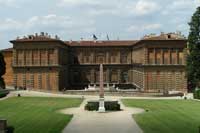
Palazzo Pitti and Boboli Gardens
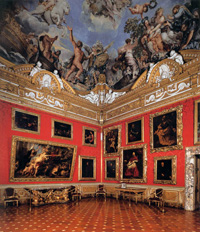
View of the Hall of Mars
|
Museum Bardini
The museum is situated in a fine building refurbished by Stefano Bardini at the end of the 18th century and donated by its owner to the Municipal Administration of Florence in 1922. Bardim was a famous art dealer who collected objects of different periods and of high quality. Even the building itself is remarkable for its use of doors, windows and mouldings of old fragments originally belonging to ruined churches and villas. The ceilings are magnificent examples of Venetian and Tuscan woodwork ranging from the 15th to the 17th centuries. The collection comprises sculptures, paintings, furniture pieces, ceramic pieces, tapestries but also fragments of the old centre of Florence salvaged before its destruction. All these items are displayed on the ground and the first floors according to a layout that fully reflects the character of a typically private collection, with the touch of a rather suggestive setting. In addition to Roman sarcophagi, capitals, Roman and Gothic relief work, there are also other remarkable examples like the -work of the Delia Robbia brothers (15th and 16th century), works attributed to Donatello and to Nino or Giovanni Pisano, in addition to the famous Charity by Tino di Camaino (1280 app.-1337). The most outstanding painting of the collection is perhaps St. Michael Archangel by Antonio Del Pollaiolo (1431-1498), although there are many other precious works among the collections of weapons, 15th century polychrome stuccoes and wooden sculpture. The collection of old musical instruments is also worth a visit. The second floor of the building exhibits the Corsi collection that comprises some `works from the 12th to the 19th centuries, donated by Mrs. Carobbi, the widow of Corsi, in 1938 ..... from `Museums and Galleries of Florence and surroundings` ( Apt - Florence )
Museum Bardini, Piazza de`Mozzi, 1
Gardens in Tuscany | The Bardini Garden in Florence
Walking in Tuscany | Florence | San Niccolo Neighbourhood in Oltrarno |
|
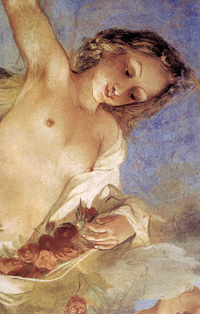
Giovanni da San Giovanni, Aurora and Tithonus (detail), 1634-35, detached fresco, 360 x 160 cm, Museo Bardini, Florence
|
 |
Questa casa di vacanza si trova fuori il paese di Cinigiano, in posizione panoramica,
con vista sulle colline che conducono al mare e l'isola Montecristo |
This article incorporates material from the Wikipedia article Giovanni da San Giovanni published under the GNU Free Documentation License.
Wikimedia Commons has media related to Giovanni da San Giovanni. |
|
|
![]()
![]()
![]()
![]()



